The versatile method of WDXRF allows for the analysis of elements in both liquids and solids. It is possible to reliably, precisely, and properly analyze elements like uranium and boron in a variety of samples. The methodology and analytical techniques are sufficiently sophisticated to offer precise qualitative and quantitative material characterization.
Thanks to recent technological developments, WDXRF has been included in standard test procedures for analytical laboratories (such as ASTM and ISO regulations) because of its affordability, dependability, simplicity, and cost-effectiveness. The cost per analysis is lower than with several traditional wet chemicals and other spectroscopic techniques.
A Compact and Independent WDXRF Instrument
Thermo Scientific™ ARLTM OPTIM’X spectrometer is a compact device with two power settings and several noteworthy analytical capabilities. It is a continuation of the company’s long history of WDXRF innovation and leadership.
- A unique WDXRF platform that can operate in simultaneous or sequential modes
- Covers elements from carbon to uranium, depending on the arrangement
- Using cutting-edge UCCO (Ultra Closely Coupled Optics) technology can increase intensity by up to 210% compared to standard geometry
- A smaller SmartGonio device for sequential analysis
- Sequential-simultaneous configuration mixing speed coupled with analytical flexibility
- Multichromators for fast analysis
- Outstanding precision (both short- and long-term repeatability) as a result of temperature control in the spectrometer and crystals
- Superior spectral resolution (~15 eV at Ca Kα and ~30 eV at Mn Kα) from low Z elements to heavy elements in comparison to EDXRF
- The best design (in accordance with ISO or ASTM standards) for a given application with streamlined operation
- Stand-alone and autonomous operation without water cooling
- No gas supply (depending on the setup) and no compressed air
- Simple and direct sample introduction
- Automatic analysis of batches with sample changer
- Small footprint
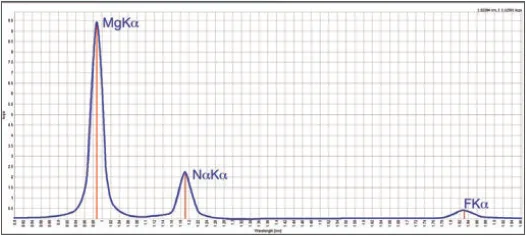
Excellent resolution compared to EDXRF: Mg, Na and F peaks do not interfere on each other. Image Credit: Thermo Fisher Scientific - Elemental and Phase Analysis
Configuration for Speed and Flexibility
- Four multichromators can show up to eight objects at once
- Sequential analysis with the SmartGonio
- Sequential-simultaneous analysis: two elements on the same multichromator using SmartGonio
- 50 W basic or 200 W optional power to produce a 2.5 times quicker analysis
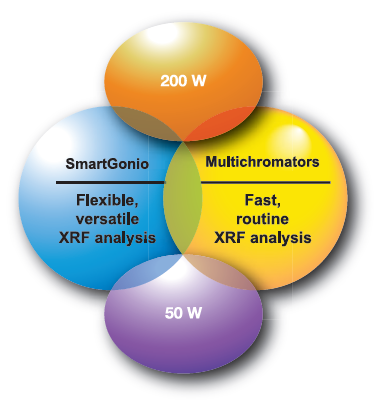
Configuration selected according to application needs. Image Credit: Thermo Fisher Scientific - Elemental and Phase Analysis
Large Variety of Samples
The ARL OPTIM’X spectrometer can evaluate various samples, including conductive and non-conductive solids, liquids, loose powders, pressed pellets, fusion beads, pastes, granules, and coatings. The instrument is tailored to individual application requirements.
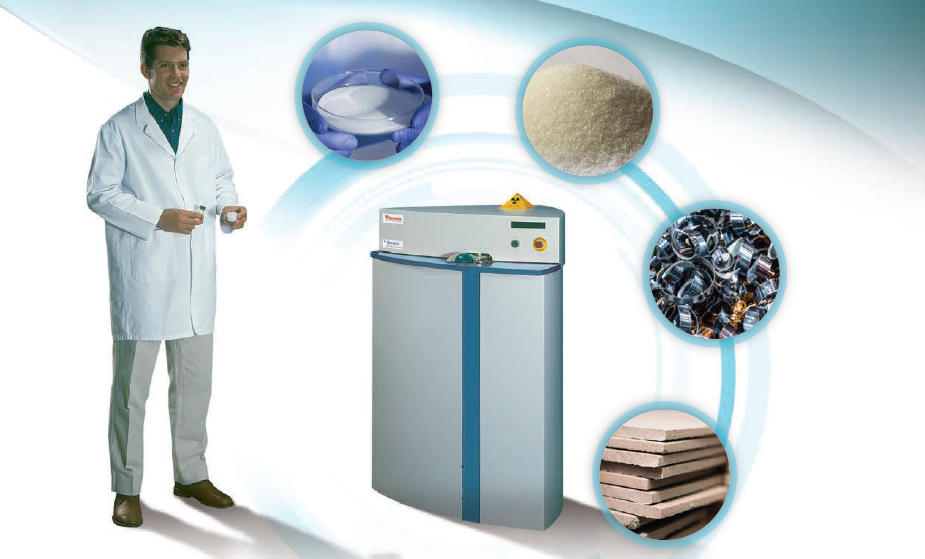
Image Credit: Thermo Fisher Scientific - Elemental and Phase Analysis
Exclusive UCCO Technology
UCCO–Ultra Closely Coupled Optics
- 200 W performance from 50 W power
- 500 W performance from 200 W power
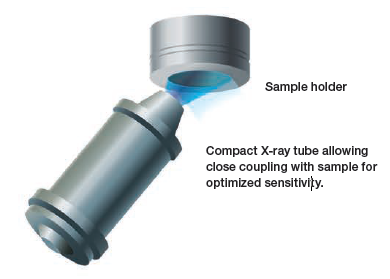
Whole X-Ray beam exciting the full sample diameter for the highest efficiency: no photon loss during irradiation. Image Credit: Thermo Fisher Scientific - Elemental and Phase Analysis
Optimized for Specific Applications
- Petroleum Industry- Examination of S (ISO 14596 or ASTM D2622), Pb (ASTM D5059), and other components present in fuels, oils, catalysts, and gasoline. The calibration curve for sulfur in lubricants and gasoline may be easily produced for values ranging from ppm to 5% (see Fig. 1). At 50 W, the best detection limit is 1.4 ppm in 100 seconds (or 1 ppm in 200 seconds). Table 1 shows that the repeatability test produced a positive result. The same precision is achieved in 50 seconds with 200 W power, and the detection limit falls to 0.8 ppm in 100 seconds. ARL OPTIM'X Sulfur Analyzer, preconfigured, is provided as a turnkey solution.
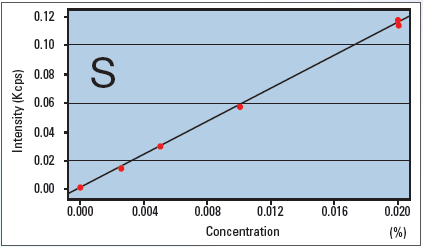
Fig 1. Calibration curve for S in oils and gasoline at 50 W (low concentration range). Image Credit: Thermo Fisher Scientific - Elemental and Phase Analysis
Table 1. Excellent reproducibility for sulfur in oils at 50 W (120 s). Source: Thermo Fisher Scientific - Elemental and Phase Analysis
| Sample |
ppm |
| Cell 1 |
25.4 |
| Cell 2 |
25.7 |
| Cell 3 |
26.4 |
| Cell 4 |
26.0 |
| Cell 5 |
25.0 |
| Cell 6 |
25.9 |
| Cell 7 |
26.7 |
| Average |
25.9 |
| Std. Dev. |
0.58 |
- Oxides can be found in raw materials such as cement, clinker, raw meal, limestone, sand, feldspar, bauxite, and magnesite. For such materials, the ARL OPTIM’X analyzer has an extraordinary level of repeatability. The preconfigured ARL OPTIM’X Cement Analyzer is now available for particular cement applications
- The preconfigured ARL OPTIM’X Slag Analyzer provides a complete solution for metallurgical slag analysis. The calibration curve in Fig. 2 shows that the analysis of F can be done with the SmartGonio or a fixed channel without problems. Table 2 demonstrates the high accuracy of ARL OPTIM'X, as well as data on fluorine
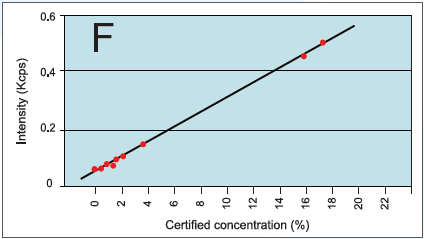
Fig 2. Calibration curve for F in slags. Standard error of estimate is 0.2% in a range from 0.1% to 17% . Image Credit: Thermo Fisher Scientific - Elemental and Phase Analysis
Table 2. Repeatability test on a pressed slag sample at 200W (6 consecutive runs). Total counting time 230 s for 13 elements - Fluorine is measured on a fixed channel. Source: Thermo Fisher Scientific - Elemental and Phase Analysis
| Run # |
CaO |
SiO2 |
Al2O3 |
Fe2O3 |
MnO |
MgO |
S |
V2O5 |
TiO2 |
K2O |
P2O5 |
Na2O |
F Mono |
| 1 |
39.58 |
35.37 |
10.05 |
0.984 |
2.42 |
5.43 |
0.954 |
0.209 |
0.811 |
1.506 |
0.641 |
1.4 |
0.493 |
| 2 |
39.61 |
35.33 |
10.06 |
0.984 |
2.43 |
5.43 |
0.948 |
0.213 |
0.812 |
1.512 |
0.642 |
1.41 |
0.484 |
| 3 |
39.63 |
35.41 |
10.05 |
0.993 |
2.42 |
5.44 |
0.946 |
0.212 |
0.819 |
1.511 |
0.646 |
1.39 |
0.477 |
| 4 |
39.55 |
35.38 |
10.07 |
0.985 |
2.42 |
5.43 |
0.953 |
0.213 |
0.812 |
1.514 |
0.646 |
1.40 |
0.491 |
| 5 |
39.62 |
35.4 |
10.06 |
0.993 |
2.42 |
5.44 |
0.953 |
0.210 |
0.811 |
1.508 |
0.647 |
1.37 |
0.471 |
| 6 |
39.57 |
35.37 |
10.06 |
0.987 |
2.43 |
5.47 |
0.954 |
0.209 |
0.815 |
1.513 |
0.645 |
1.41 |
0.486 |
| AVG |
39.59 |
35.38 |
10.06 |
0.988 |
2.42 |
5.44 |
0.951 |
0.211 |
0.813 |
1.511 |
0.645 |
1.40 |
0.484 |
| SD |
0.031 |
0.028 |
0.008 |
0.004 |
0.005 |
0.015 |
0.003 |
0.002 |
0.003 |
0.003 |
0.002 |
0.015 |
0.008 |
| Meas Time [s] |
10 |
10 |
20 |
10 |
20 |
20 |
30 |
20 |
20 |
20 |
20 |
30 |
230 |
- Oxides, both major and minor, are used in refractories, glasses, and ceramics.
- Monitoring main and minor components is necessary for numerous products such as polymers (refer to Table 3), paints, pigments, paper, ferroalloys, silicon, and metal sheets
Table 3. Limits of detection for heavy elements in polymers at 200 W (100 s counting time). SEE: standard error of estimate with ranges from 0 to 500 ppm. Source: Thermo Fisher Scientific - Elemental and Phase Analysis
| |
|
LOD in 100 s |
SEE |
| Element |
Line |
[ppm] |
[ppm] |
| Ba |
Lα |
2.6 |
17 |
| Br |
Kα |
1.0 |
6.1 |
| Cr |
Kα |
0.5 |
3.6 |
| Cu |
Kα |
0.5 |
5.6 |
| Hg |
Lα |
1.2 |
20 |
| Ni |
Kα |
0.3 |
16 |
| Pb |
Lβ |
0.9 |
24 |
| Zn |
Kα |
0.3 |
6.2 |
- The food industry regulates main and minor nutrients in milk powders and cereals. Table 4 shows typical concentration ranges and excellent detection limits for milk powders at 50 W
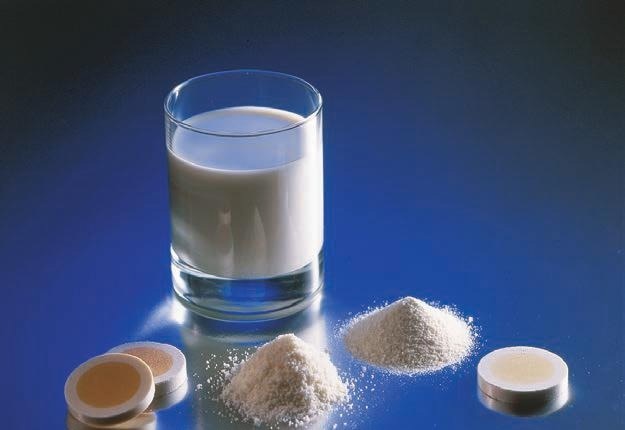
Image Credit: Thermo Fisher Scientific - Elemental and Phase Analysis
Table 4. Limits of detection (LoD) at 50 W in milk powders prepared as pressed pellets (*cumulative counting time of SmartGonio for Na and Mg). Source: Thermo Fisher Scientific - Elemental and Phase Analysis
| Element |
Analytical device |
Typical ranges |
LoD (ppm in 60 s) |
| Na |
Fixed channel |
0 – 0.03% |
20 ppm* |
| Mg |
Fixed channel |
0 – 0.12% |
11 ppm* |
| P |
SmartGonio |
0 – 1.1% |
4.4 ppm |
| K |
SmartGonio |
0 – 1% |
2 ppm |
| Ca |
SmartGonio |
0 – 1.6% |
10 ppm |
| Fe |
SmartGonio |
0 – 0.33% |
2.1 ppm |
| Cu |
SmartGonio |
0 – 0.012% |
0.6 ppm |
| Zn |
SmartGonio |
0 – 0.2% |
2 ppm |
| Cl |
SmartGonio |
0 – 0.48% |
10 ppm |
| Mn |
SmartGonio |
0 – 0.0023% |
1.2 ppm |
| Se |
SmartGonio |
0 – 3.4 ppm |
0.24 ppm |
(*-cumulative counting time of SmartGonio for Na and Mg)
- For wide-range and unknown material analysis, Thermo Fisher offers an ARL OPTIM’X Uniquantometer that is already set up
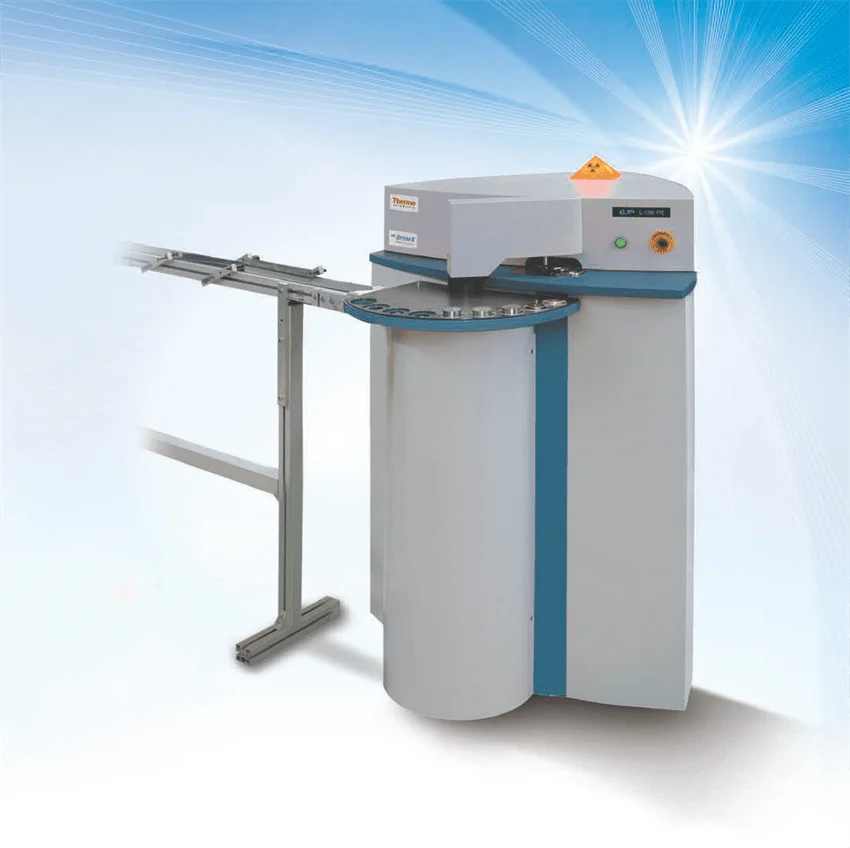
Full automation with Thermo Scientific ARL SMS-Omega loading system connecting full automatic preparation machines. Image Credit: Thermo Fisher Scientific - Elemental and Phase Analysis
Exclusive SmartGonio – Principle of Operation
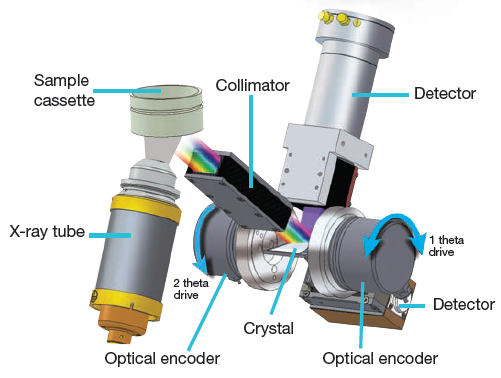
Image Credit: Thermo Fisher Scientific - Elemental and Phase Analysis
- Quantitative examination of elements ranging from F to U based on configuration
- Moiré fringe optical encoders are used for angular positioning, ensuring a Ɵ/2Ɵ connection between the crystal and detector
- Good repeatability and angular accuracy
- No friction, no wear and no maintenance
- Crystal temperature control for optimal analytical stability
- The X-Ray tube’s closest coupling offers the best sensitivity
Top Analytical Software
Instrument Control and Data Handling
Thermo Scientific OXSAS™ software is state-of-the-art and facilitates rapidly generating extremely accurate analytical results while making the ARL OPTIM’X spectrometer easy to use. OXSAS software, which runs on the Windows® 10 operating system, is designed to adjust to changing client needs and the instrument’s lifetime by giving them the latest solutions. The OXSAS software’s product specification paper includes all the features and details.
Uniquant
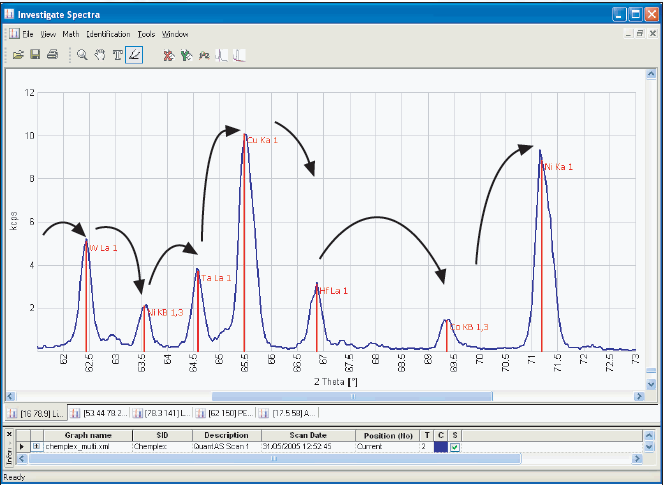
Uniquant uses ‘peak hopping’ to acquire intensities for more than 121 line positions. Image Credit: Thermo Fisher Scientific - Elemental and Phase Analysis
The well-known UniQuant™ application for the ARL OPTIM’X spectrometer provides “standard-less” analysis for up to 73 elements in cases where specific standards are not available, samples are only available in restricted quantities, or samples have irregular shapes.
It is possible to analyze any type of solid, conductive or non-conductive. When the helium environment option is activated, analyzing loose powders, liquids, and pastes becomes simple. The Uniquant program also identifies the sample's remaining unanalyzed components, such as organic and ultralight components. Peak-to-peak hopping analysis has several advantages over scan-based spectral processing.
- Improved limits of detection
- Optimal counting time for every element
- Sample spinning is used for samples that are not homogenous or to average out the impacts of polishing grooves
The Uniquant software is fully calibrated and pre-installed at the factory using the SmartGonio of the ARL OPTIM’X spectrometer, making it immediately usable upon installation at the user’s site. Stable samples for long-term setup and maintenance are included. The preconfigured version of the ARL OPTIM’X analyzer is called the ARL Uniquantometer.
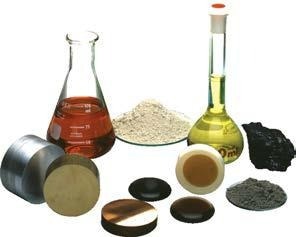
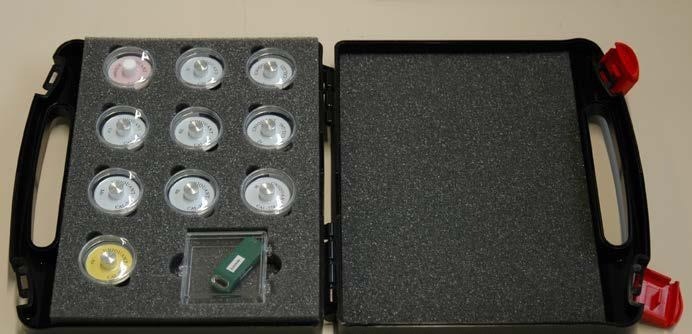
UniQuant is the world’s most renowned standard-less package. Image Credit: Thermo Fisher Scientific - Elemental and Phase Analysis
Fast Qualitative Analysis
With step scanning, precise peak definition is possible due to its 0.001° resolution. For speedy qualitative analysis, spectra can be quickly captured at up to 327 °/min with continuous digital scanning. The peaks automatically identify themselves with the items that have been detected.
Accuracy Made Easy
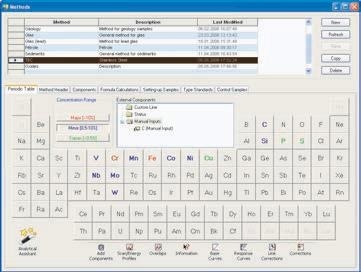
The Analytical Assistant helps definition of analytical programs, calibration and instrument use. Image Credit: Thermo Fisher Scientific - Elemental and Phase Analysis
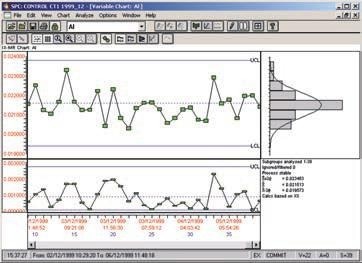
Statistical Process Control – Typical screen. Image Credit: Thermo Fisher Scientific - Elemental and Phase Analysis
The online analytical assistant can be used to define analytical programs and calibrations rapidly and reliably. The multi-variable regression (MVR) tool creates the various calibration curves. Correction models improve analysis accuracy by lessening the effect of interfering components in multi-component matrices. These types of models are:
- Line overlap correction
- Additive correction on intensities
- Additive correction on concentrations
- Multiplicative correction on intensities
- Multiplicative correction on concentrations
- Multiplicative and additive corrections on concentrations
- Comprehensive LAchance (COLA) with three-term alphas is used by the NBSGSC fundamental parameters program, which replicates analytical calibrations for homogeneous materials. The inter-element correction factors, or theoretical alphas with matrix and LOI/GOI removal now included, are used by the MVR as computed known coefficients. This improves analytical precision and lowers the number of standards needed to produce calibrations
Turnkey Calibrations
A variety of materials are available for ex-works calibrations, such as:
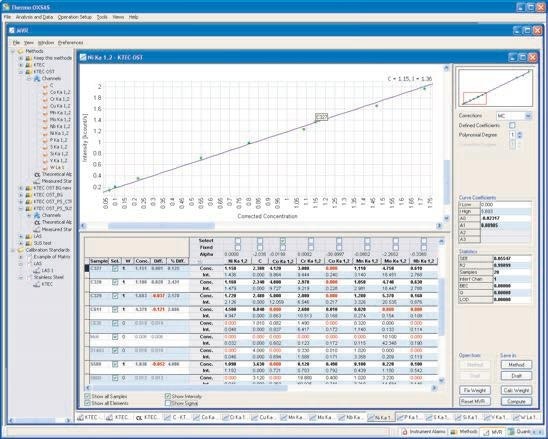
MVR calibration curve: real concentration vs. intensities. Image Credit: Thermo Fisher Scientific - Elemental and Phase Analysis
- Petroleum industry products using the PetroilQuant program and/ or ASTM & ISO methods
- Iron, hot metal and slags
- Copper, bronze and brass
- Aluminum and alloys
- Ferro-alloys
- Cement and clinker
- Various oxides through the
- General Oxide calibration
- Traces in soils and sediments
- Polymers and coatings
- Minerals such as lime, limestone, dolomite and sands
- Glasses
- Milk powders and cereals
- S and Cl in catalysts
- For custom calibrations in addition to the above-specified calibrations, requests for analytical requirements could be made
Specifications of the Thermo Scientific ARL OPTIM’X XRF spectrometer. Source: Thermo Fisher Scientific - Elemental and Phase Analysis
| . |
. |
| Element range |
Oxygen (Z=8) to uranium (Z=92) with 2 detectors fitted. Oxygen to Iron (Z=26) with FPC detector fitted (Carbon (Z=6) can be fitted as fixed channel) |
| Spectrometer environment |
Vacuum for solids, helium for liquids and loose powders |
| Spectrometer design |
Analysis devices contained in a temperature-controlled vacuum chamber made of grey cast iron |
| Spectrometer arrangement |
X-ray tube inclined at 66° under sample for optimum incidence |
| Spectrometer capacity |
Simultaneous configuration: Four Multichromators (covering eight elements)
Sim-seq configuration: SmartGonio + one Multichromator (covering two elements) |
UCCO
technology |
Ultra Closely Coupled Optics offering the largest solid angle for most efficient irradiation of the total sample surface: 50 W power providing excitation similar to 200 W or 200 W power providing excitation similar to 500 W |
| X-ray excitation |
Air-cooled Rh anode end window tube with thin Be window (0.075 mm). Other anodes available on request. 50 W version: Solid-state high-frequency generator of maximum voltage 50 kV and maximum current 2 mA (combinations to be chosen to be at 50 W) 200 W version: maximum voltage 50 kV and maximum current 10 mA (combinations to be chosen to be at 200 W). Max. line voltage variation 230 V -15% to +10%. Stability ± 0.0002% per 1% variation |
| SmartGonio |
Fully automatic, gearless, microprocessor-controlled compact goniometer using optical encoders
Total angle range: 0 ˚ -150 ˚ 2 θ (Flow proportional counter: 17 ˚ -150 ˚, Scintillation counter: 0 ˚- 90 ˚ ).
Continuous digital scans: from 0.25 ˚/min to 1200 ˚/min. |
| Multichromator |
Fixed channel using dual curved crystal optics allowing analysis of two elements simultaneously. Sealed detectors available for elements from sodium (Z=11). Flow proportional or scintillation detectors also available depending on element. Dual pulse height integration to discriminate and correct for 2nd order peaks. Note: some elements can only be fitted as single channel monochromator |
| Counting electronics |
Multi-channel analyzer to discriminate peaks of higher energies. Digital Automatic Gain Control (AGC) for pulse shrinking correction.
Automatic dead time correction ensures linearity of response up to 2 Mcps on flow proportional counter and 1.5 Mcps on scintillation counter |
| Sample loading |
Basic: 1 position for cassette or liquid cell. Optional: 13-position autosampler |
| Automation |
ARL SMS-Omega full automation with transport link from/to fully automatic sample preparation machines for pressed pellets or fused beads or solids |
| Sample holders |
Sample cassettes with maximum size of sample: height 26 mm, diameter 52 mm. Liquid cell: height 22 mm, external diameter 40 mm
Exposed opening: 29 mm diameter (basic). Rotation of sample holder in analysis position: 6 to 60 rpm |
| Dimensions and weight |
H 126 cm, W 88 cm, D 82 cm with basic sample loading. System weight: approximately 260 kg |
| Laboratory information |
Optional phone service support through modem connection |
| Power requirements |
1.5 kVA single phase at 50 W; 1.7 kVA single phase at 200 W |
Safety Standards. Source: Thermo Fisher Scientific - Elemental and Phase Analysis
| . |
. |
| Electrical and protection |
EN IEC 61010-1 (Safety requirements for electrical equipment for measurement, control and laboratory use. Part 1: General requirements) |
| Radiation |
Full protection system: Swiss directive ORaP RS 814.501 and German directive RöV BGB1.IS.114 |
| Electro-magnetic immunity |
EN CEI 61326-1 (Electrical equipment for measurement, control and laboratory use – EMC requirements – Part 1: General requirements) |
| European directives |
2006/95/EC (LVD) Low Voltage Directive
2011/65/EC (RoHS) Restriction of Hazardous Substances Directive
2002/96/EC (WEEE) Waste Electrical and Electronic Equipment Directive |